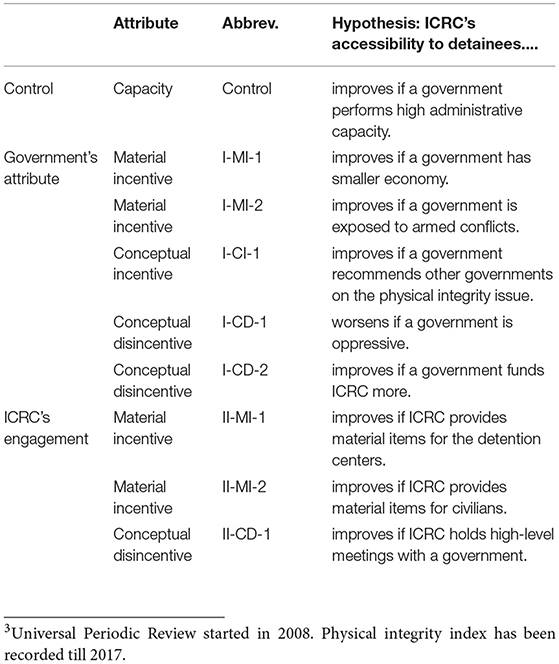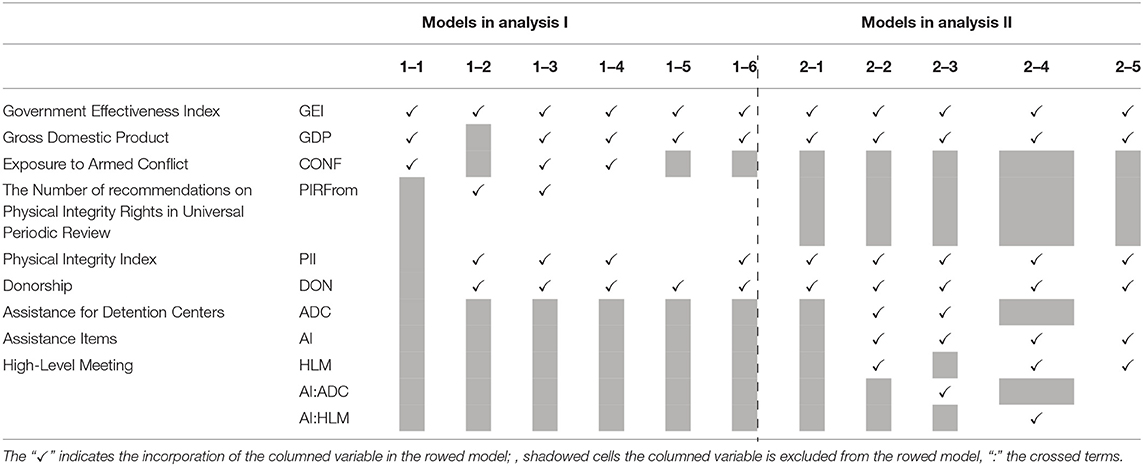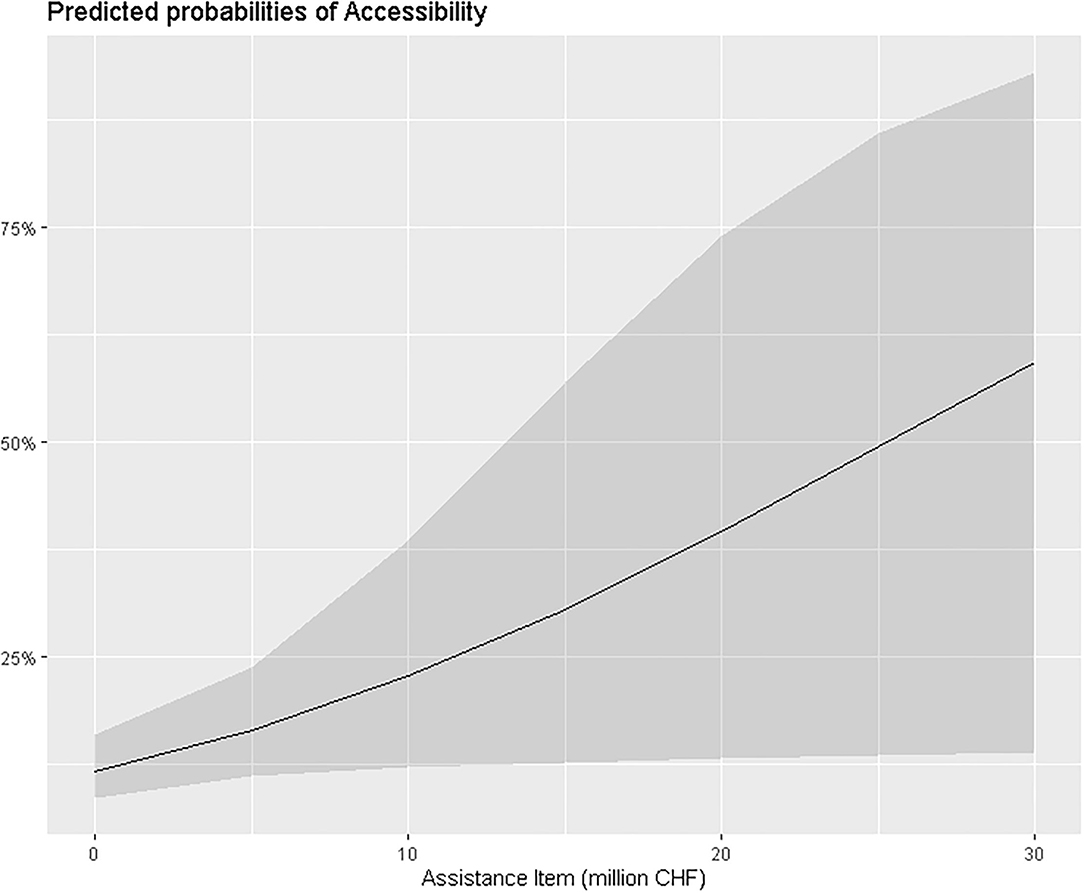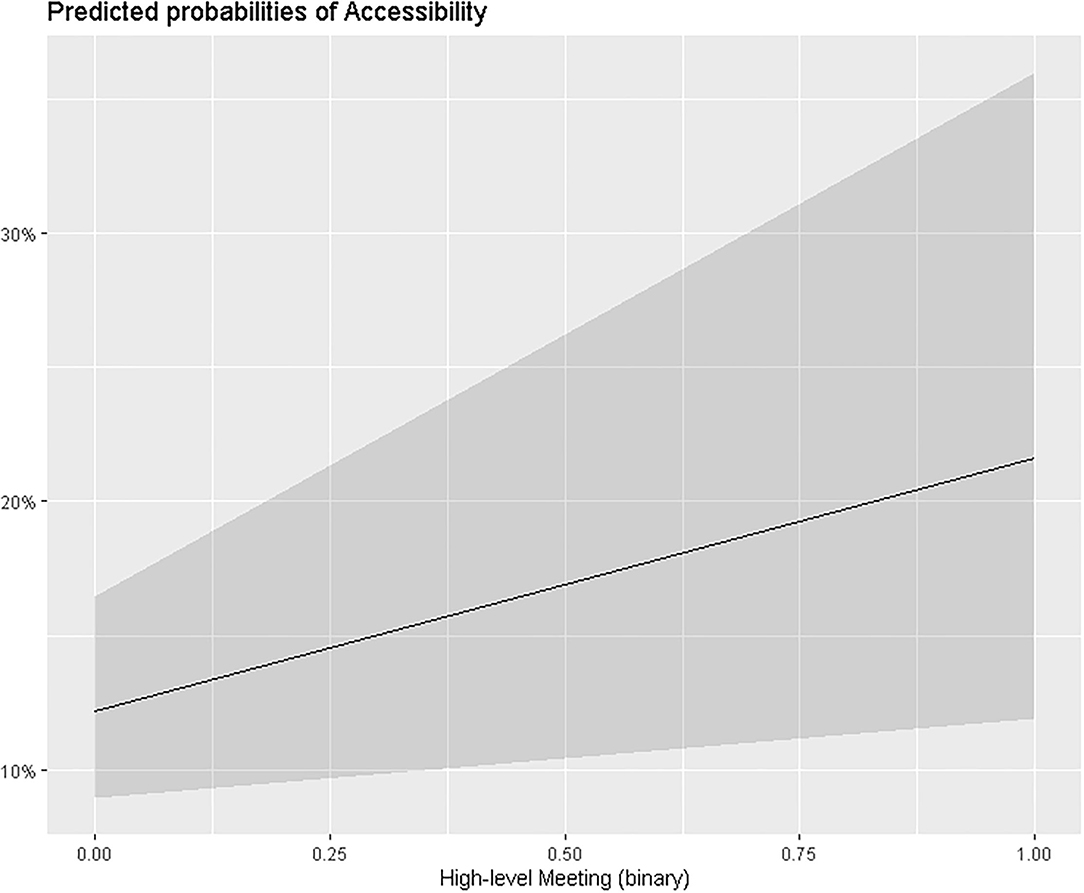- Graduate School of Advanced and Integrated Studies in Human Survivability, Kyoto University, Kyoto, Japan
The importance of humanitarian access has been widely recognized by practitioners and scholars. Nevertheless, the factors behind its success have been not yet fully clear. This study, therefore, conducted a quantitative analysis of the International Committee of the Red Cross's (ICRC) access to detainees' visits to elucidate the success factors of humanitarian access. It analyzed a government's attributes that grant the ICRC access and engagements to soften the government's refusal of its access. The results revealed the following findings: (1) a government's capacity is required to an extent to keep public services in armed conflict; (2) material incentive (MI) in a government is working, and the ICRC assistance for civilians is effective; (3) conceptual incentive (CI) to seek the international legitimacy is irrelevant; (4) conceptual disincentive (CD) to avoid disclosure of the government's violation of humanitarian norms is working, and a high-level meeting with the ICRC is less likely to lessen the government's concern. These findings supplement insights of previous research on general humanitarian access in a quantitative way, implying the possibilities and the limits of humanitarian agency's engagements. Further research on various types of humanitarian success can clarify its success factors in a more specific way.
Introduction
The importance of humanitarian access has been widely recognized by practitioners and scholars. It is defined as “humanitarian actors' ability to reach populations affected by crisis as well as an affected population's ability to access humanitarian assistance and services” (UNOCHA, 2017, p. 1). Although challenges to humanitarian access include physical barriers such as the destruction of infrastructure, an authority1 controlling those people still plays an important role in securing humanitarian access. Some authorities try to block humanitarian access by, for example, restricting entry of the staff, harassing, and firing on the supply chain (Rohwerder, 2015, p. 3–4). Faced with those challenges, humanitarian organizations employ various ways to convince it to open the access to beneficiary people. Some negotiations succeed, but others fail. The factors behind its success remain unclear. Studies have pointed out the attributes of an authority that grants humanitarian access from the perspective of its incentive structure and capacity: the authority seeking approval from the international community and with higher administrative capacity usually permits access. However, there is no guarantee that these attributes alone influence humanitarian access. Other aspects, such as the size of the economy, presence or absence of conflict, and relationship with the humanitarian organization, may also have an impact. Some authorities who refuse the visit may also soften their attitude by engaging in working with the humanitarian organization. However, research has not clarified this point comprehensively.
Therefore, this study explores the success factors of humanitarian access by conducting a quantitative analysis of the International Committee of the Red Cross's (ICRC) access to detainees. First, it analyzes a government's attributes that grant the ICRC access from the viewpoint of a general material/conceptual dis/incentive structure. Second, it analyzes the ICRC efforts to soften the authority's attitude of refusing the ICRC access.
Scope
Literature Review
Refusal or permission of humanitarian access by authorities has been reported by practitioners. Those case reports explain political obstacles on the ground encountered and compromise to obtain humanitarian access (Anderson, 1999; Terry, 2002). They did not provide analytical viewpoints but raised ethical and retrospective questions over “how could humanitarian assistance avoid harm.” Such negotiation with authorities has been termed “humanitarian diplomacy” (Minear, 2007) or “humanitarian negotiation” (Allié, 2011). This has accompanied the development of manuals or guidebooks for staffs on the ground to advise what they should take care of in negotiation with warring parties, especially non-state armed groups (Mancini-Griffoli and Picot, 2004; Hugh and Bessler, 2006).
Following these literature developments led by rather practical concerns, analytical research has appeared mostly since the 2000s. It has been acknowledged that the authority's governance capacity for public service affects humanitarian access (Glaser, 2005, p. 13–17). When an authority wants to grant humanitarian access, it cannot guarantee the safety of agencies because of its inability to force local militias to obey rules.
Apart from capacity, scholars have analyzed the factors that prompt an authority to grant humanitarian access by mainly focusing on their incentives. Access is granted because an authority values the material assistance delivered (Del Valle and Healy, 2013; Wood and Sullivan, 2015) and because they want to legitimize their territorial control by supervising the allocation of assistance (Terry, 2002; Mampilly, 2011, p. 8). The former can be categorized as a material incentive (MI) and the latter as a conceptual incentive (CI). However, authorities also have disincentives to grant humanitarian access. When humanitarian assistance reaches people controlled by opposition groups, it can endanger the military equilibrium (Labonte and Edgerton, 2013). Another disadvantage is the risk of being a witness. A government, especially an authoritarian one, may not want humanitarian organizations to see the violations of international humanitarian law or human rights law (Cunningham, 2018, p. 28). The government can recognize the existence of humanitarian organizations as interference to destabilize its control (Paik, 2011, p. 440). The former is a material disincentive, and the latter is a conceptual disincentive (CD).
Given the dis/incentive structure of the authority, humanitarian organizations can wield several strategies that alter that structure to let themselves in. It is widely known that some portions are handed over to the central or local authorities to secure smoother access, thus leveraging an authority's MI (Cutts, 1999, p. 44; Haver and Carter, 2016, p. 50–52). To capitalize on an authority's CI, humanitarian organizations can threaten to denounce the authority's violations of international norms. Especially during an armed conflict, an authority tries to portray itself as respectable to send a positive signal to the international community (Bangerter, 2011, p. 360). Social capital between humanitarian organizations and authorities is highlighted to improve those successful factors (Tuck, 2011; Grace, 2020). Humanitarian organizations can persuade authorities to find their own interests in securing humanitarian access (Clements, 2018). They can also assure the authority of their confidentiality, wherein they do not speak about what they witness, including the abuses committed, thus decreasing disincentive (Herrero, 2014, p. 7). Some researchers currently organize a list of challenges to humanitarian access and the way to overcome those challenges (Moslehi et al., 2015; Rohwerder, 2015; Kunz and Reiner, 2016).
Despite these achievements, research still has room for improvement. It has failed to analyze factors behind the success in a quantitative way owing to the difficulty in collecting data in the humanitarian sector. As one-panel discussion points out, “[d]ata are often collected for pure reporting and accountability reasons and these data are not exactly useful for analysis” (Kunz et al., 2017, p. 1,590).
To overcome this problem, this study analyzes the ICRC access to visit detainees2 because those activities are implemented on a large scale and recorded in a unified manner and because they sometimes fail to get access. The ICRC monitors to ensure that detainees live in decent conditions and receive humane and fair treatment in accordance with applicable laws and conditions (ICRC, 2016, p. 9). The ICRC has conducted visits to detainees for more than 50 years and currently covers many countries and detainees. In 2015, the ICRC visited 928,000 detainees in 133 countries. The ICRC access to detainees, except for access to prisoners of international war, does not have such a legal base. Although the ICRC justifies its access on the recognition of its consistent practices by governments via international conferences (Aeschlimann, 2005, p. 87–89), some authorities do not grant the ICRC access to detainees, for example, out of the sovereignty concern (Moreillon, 1974, p. 173). The ICRC records if it could visit detainees or not, and if so, the number of visits, detainees, and places. As noted below, those records are not complete in detail but unified across the history and countries. Therefore, this study employs the ICRC access to detainees as cases to analyze the factors to improve humanitarian access.
Out of different concerns from this study, there are two types of research dealing with the ICRC access to detainees. A study on the ICRC access to detainees explores the attributes of rebel groups: centralized administration and sensitivity to demands from the international community or its people work positively; the degree of brutality works negatively, possibly due to the fear of being presented before the International Criminal Court (Jo and Bryant, 2013). Another investigation emphasizes an authority's interest in showing domestic or international legitimacy because having good relationships with the ICRC can indicate good governance. Thus, democracy and dependence on foreign support work positively. Armed conflicts work negatively because of damage to the administrative capacity (Jo and Thomson, 2014).
However, their research designs are not enough for this study's concern. They focus on access to cases entailed in armed conflicts, and they do not consider the ICRC engagement to soften the attitude of the authorities that refused the access. However, their purposes are to analyze the factors for rebel groups to comply with international norms exemplified by granting the ICRC visits to detainees. They do not have to analyze the cases of no-conflict situations because there are very few rebel groups that do not fight and co-exist with the government, nor have to analyze the ICRC engagements.
Research Purpose
This study explores the factors for authorities to grant humanitarian access by examining humanitarian access with a quantitatively operational dataset of the ICRC access to detainees. It amends the analytical framework of earlier studies from three perspectives. First, it analyzes authorities in general situations in both armed conflicts and no-conflict situations. Since there are very few rebel groups in no-conflict situations, this study includes only cases of governments. Second, it examines changes in the decision of a government pertaining to granting the ICRC access. Third, it analyzes the ICRC engagements to induce a government to grant access.
Research Hypotheses
This study tests the following hypotheses to statistically analyze the factors that improve the ICRC accessibility. Table 1 presents a summary of the hypotheses.
Government's Capacity
This study accepts the assumption of previous research on a government's capacity and set it as a control hypothesis.
Material Incentive
Regarding MIs, the ICRC accessibility to detainees improves if a government does not want it to stop delivering material assistance to the country. There are few cases, however, where the existing humanitarian operations are leveraged to secure access to another beneficiary (e.g., Richardson, 2002, p. 76). More frequently, organizations have withdrawn their demand for new access for fear of losing current access. However, the difficulty in creating additional access derives from possible military losses caused by the exploitation of humanitarian assistance by opposing groups. Humanitarian access to detainees can be less exploited because detainees in almost cases are interned in the government-controlled area. Therefore, the leverage of MIs to grant access to detainees is not offset by material disincentives. The leverage is expected to accord with the value of humanitarian assistance, which depends on the scale of the economy and the urgency faced by the country. In turn, the ICRC can leverage MI to induce the government to grant access to detainees. There are two routes for material assistance, namely, for local detention centers and for overall civilians.
Conceptual Incentive
Regarding CIs, the ICRC accessibility to detainees improves if the government obtains legitimacy by granting it access to detainees. Although previous research has analyzed the dependence on foreign assistance, this study did not because it included developed governments receiving none from other governments. Instead, this study examined the international legitimacy of physical integrity rights3. If a government recommends other governments to reform physical integrity rights, it is expected to qualify on the issue by granting the ICRC access in order to avoid backlash about failing the test of international legitimacy. The leverage of CIs is expected to accord with the government's approach to other governments' physical integrity rights. While humanitarian organizations sometimes threaten to denounce the government's violation of international norms, the ICRC is known to denounce it less often than other humanitarian organizations (Bussmann and Schneider, 2016, p. 341). Of course, it does especially when faced with a gross violation of International humanitarian law (Kellenberger, 2004, p. 599). However, the author could not find any tangible evidence that the ICRC criticizes a government or threatens to gain access to detainees. The ICRC rarely suspends its negotiation for access to detainees when it supposes that the negotiation would make no fruit like a case in Tajikistan (ICRC, 2010, p. 289). Still, the ICRC does not publish critical statements against the government's oppressive measures. Therefore, this study did not consider the ICRC engagement based on CIs.
Conceptual Disincentive
Regarding CD, the ICRC accessibility to detainees worsens if a government finds a risk of losing legitimacy by granting it access to detainees. Detainees under the target of the ICRC visits are often at risk of ill-treatment (ICRC, 2016, p. 6). Some governments do not recognize the existence of such detainees (Forsythe, 1975). They do not want detainees to be exposed to international criticism. The ICRC does not disclose its findings, so governments could estimate the risk of permitting the ICRC visits to be lower than that of other humanitarian organizations, such as Médecins sans Frontières (Kotsioni, 2016). However, the government may suspect the ICRC confidential approach as the ICRC report about the detention center is leaked quite often, but not never (Lewis, 2004). The leverage of CDs is expected to accord with the government's concerns about exposure, which depends on the degree of physical integrity's violations. Conversely, the concern could be lessened by the interorganizational trust of the government in the ICRC commitment. Interorganizational trust can be developed through donorship. The donor government can be convinced that the ICRC will not harm its reputation. In turn, the ICRC could leverage CDs by holding high-level meetings where the ICRC tries to relieve the government of its concern against exposure.
Methodology
To test the hypotheses, this study conducts two analyses with logit regression (refer to Online Appendix 1 in Supplementary Material), which deal with the government's attributes covering cases mentioned in the ICRC Annual Reports from 2009 to 2017. The period is determined by data accessibility (see Footnote 3). Analysis II addresses the ICRC engagement, including cases when a government has refused to grant it access and when the government starts granting access. Analysis II covers the period from 1997 to 2017 to include more cases.
Dependent Variable
Whether the government accepts the ICRC visits each year is treated as the dependent binomial variable. “Access” case is coded 1 and “No Access”' is 0. Although this value is taken from the ICRC Annual Reports, those reports do not mention whether access to detainees is granted or not in all cases. Then, the paper codes each case with the following procedure.
To begin with, the paper categorizes ICRC accessibility to detainees sourced from its annual reports into three types: (1) “Access,” (2) “No access,” and (3) “Missing.” If ICRC visits at least one detainee, such case is coded as “Access.” If ICRC visits no detainees, such cases are classified into six types: (i) negotiation of ICRC access fails, (ii) ICRC cannot have negotiation with the government, (iii) empowerment for detention facilities is provided, (iv) general policy for detention is discussed without reference to actual detainees, (v) there are no activities mentioned with regard to detainees, and (vi) there are no detainees within ICRC purview. The paper accorded (i), (ii), and (iii) into “No Access” and (iv), (v), and (vi) into “Missing,” because in the former categories, there are detainees ICRC fails to visit, and in the latter categories, we cannot know whether negotiation would succeed if there were detainees within ICRC purview and ICRC tried to reach them.
Previous research has assumed “Missing” data as “No Access.” That assumption holds because they focus on authorities exposed to armed conflicts, where targets of ICRC visits, prisoners of war, can allegedly be present. The paper treats only governments either exposed or not to armed conflicts, and there are cases where there are no detainees within ICRC purview: type (vi). Therefore, assuming “Missing” cases as “Access refused” misleads the result.
Then, the paper treats “Missing” cases as the same of cases in the previous years on the assumption that any revision of access should be reported. For example, if 2010 is “Access” and 2011 is “Missing”, the paper assumes 2010 and 2011 as “Access”. However, if “Missing” continues for more than 5 years, “Missing” since the fifth year is coded as “Excluded.” In addition, the paper codes “No Access” which follows “Access” as “Excluded” because of the assumption, while “No Access” would change into “Access” in a linear way and “Access” would change into “No Access” in a non-linear way or abruptly. The former happens assumingly because positive factors to soften the government's attitude incrementally increase. The latter happens assumingly because some negative incident, for example, an armed conflict or political upheaval breaks out making the government's attitude toughened. As noted just below, regression models in the paper include independent variables that lagged by 1 year. Then, the paper assumes that while regression of “Access” with parameters of “No Access” in the previous year is acceptable, regression of “No Access” with parameters of “Access” in the previous year is unacceptable.
Refer to Online Appendix 2 in Supplementary Material for the number of cases in original revised datasets and Online Appendix 3 in Supplementary Material for omitted countries for several reasons.
Independent Variable
All independent variables are lagged by 1 year. The following two categories of variables are involved with the hypotheses: government attributes and ICRC engagement. In the former category, GEI implies government effectiveness index evaluated by the quality of public service and policy formulation and implementation. It is an index from 0 to 100, and the higher score is the better (Kaufmann et al., 2010)4. CONF, a binary variable, shows whether a country is exposed to an armed conflict (Sundberg and Melander, 2013; Stina, 2021). One is coded if there are more than 25 casualties in an armed conflict. PIRFrom denotes the number of governments that the government recommends to improve their physical integrity rights at the Universal Periodic Review (Terman and Byun, 2022). The paper employs the classification by Terman and Byun (2022) of many themes recommended into seven clusters including “physical integrity rights5.” Gross domestic product (GDP) is the logged value, exploited from World Bank. The physical integrity index (PII) evaluated from the degree people is protected from government killings, torture, and extrajudicial executions. It is an index from −3.8 to 5.4, and the higher is the better (Fariss, 2014, 2019). DON shows the value of funding from governments to the ICRC divided by the GDP, exploited from ICRC Annual Reports. The original value, measured by CHF, is converted into USD by the exchange rate of 31 December in a certain year.
Among the latter category, the assistance for detention center (ADC), a binary variable, indicates whether the ICRC delivers assistance materials for detainees or detention centers, exploited from ICRC Annual Reports. Assistance Item (AI) reveals the value of the assistance items delivered by the ICRC, exploited from ICRC Annual Reports6. HLM, a binary variable, indicates whether a high-level meeting is held, exploited from ICRC Annual Reports. The high-level means participation of the Director General from ICRC or minister from the government or higher level, or the headquarter agreement to set the permanent delegation.
Model
The models employed in Analysis I include only the government's attribute variables. Model 1_1 corresponds to Hypotheses I-MI-1 and I-MI-2 regarding MIs. Model 1_2 corresponds to Hypothesis I-CI-1 regarding CI and Hypotheses I-CD-1 and I-CD-2 regarding CDs. Model 1_3 incorporates all variables. Model 1_4 is the best-fitted model defined by the least degree of Akaike information criterion (AIC). Models 1_5 and 1_6 are classified according to exposure to armed conflicts to see the exposure's leverage, which are not evidenced by previous research. Owing to space limitations, Models 1_5 and 1_6 demonstrate only the best-fitted models.
The models employed in Analysis II include the government's attribute variables, which are found to be significant in Analysis I as control variables and ICRC engagement variables. Model 2_1 incorporates only the control variables. Model 2_2 corresponds to Hypotheses II-MI-1, II-MI-2, and II-CD-1 regarding the ICRC engagement in MIs and CDs. Models 2_3 and 2_4 include a crossed term to check whether combining the ICRC engagements could be effective. Model 2_5 shows the best-fitted model. Table 2 presents the combinations of the models and variables.
Results
Analysis I
Table 3 shows the results of Analysis I regarding the government's attributes to grant the ICRC access. Each figure represents the coefficient of the independent variables. The significant values are indicated in bold.
Government effectiveness index is significantly positive, especially, in Models 1_1, 1_3, 1_4, and 1_5 but not in Model 1_6. This implies that Control 1 stands partially supported. The ICRC accessibility to detainees improves if a government exposed to armed conflicts has a higher administrative capacity. When it comes to a government not exposed to armed conflicts, the ICRC accessibility to detainees does not necessarily improve even if a government has a higher administrative capacity.
Gross domestic product is significantly negative in all models. Therefore, it can be said that Hypothesis I-MI-1 stands supported. The ICRC accessibility to detainees improves if the government has a smaller economy. The positive effect of a smaller economy manifests more in armed conflicts, as shown by the difference between Models 1_5 and 1_6.
CONF is significantly positive in all models. This result indicates that Hypothesis I-MI-2 stands supported. The ICRC accessibility to detainees improves if the government is exposed to armed conflicts.
PIRFrom is insignificant in all models except Model 1_2. Thus, Hypothesis I-CI-1 is not supported. The ICRC accessibility to detainees does not improve if a government recommends other governments more frequently on the issue of physical integrity.
Physical integrity index is significantly positive in all models except Model 1_5. Thus, Hypothesis I-CD-1 stands partially supported. The ICRC accessibility to detainees worsens if a government not exposed to armed conflict is more oppressive. When it comes to a government exposed to armed conflicts, the ICRC accessibility to detainees does not necessarily worsen even if a government is more oppressive.
DON is significantly positive in all models except for Model 1_5. Thus, Hypothesis I-CD-2 stands partially supported. The ICRC accessibility to detainees improves if a government not exposed to armed conflicts funds the ICRC more. When it comes to a government exposed to armed conflicts, the ICRC accessibility to detainees does not necessarily improve even if a government funds the ICRC more.
The figures show the ICRC accessibility predicted by key variables, with other variables set to average values. Gray shading indicates the 95% confidence interval. Figure 1 shows the value predicted by the GEI in Model 1_5; Figure 2 shows the value predicted by PII in Model 1_6; Figure 3 shows the value predicted by DON in Model 1_6. Figure 4 shows two predictions by GDP in Model 1_4 according to exposure to armed conflicts. The red part, representing cases not exposed to armed conflicts, shows a milder drop than the blue part, representing the cases exposed to armed conflicts. Two parts indicate that, although exposure to armed conflicts improves the ICRC accessibility to detainees, its leverage diminishes in a government with a large economy.
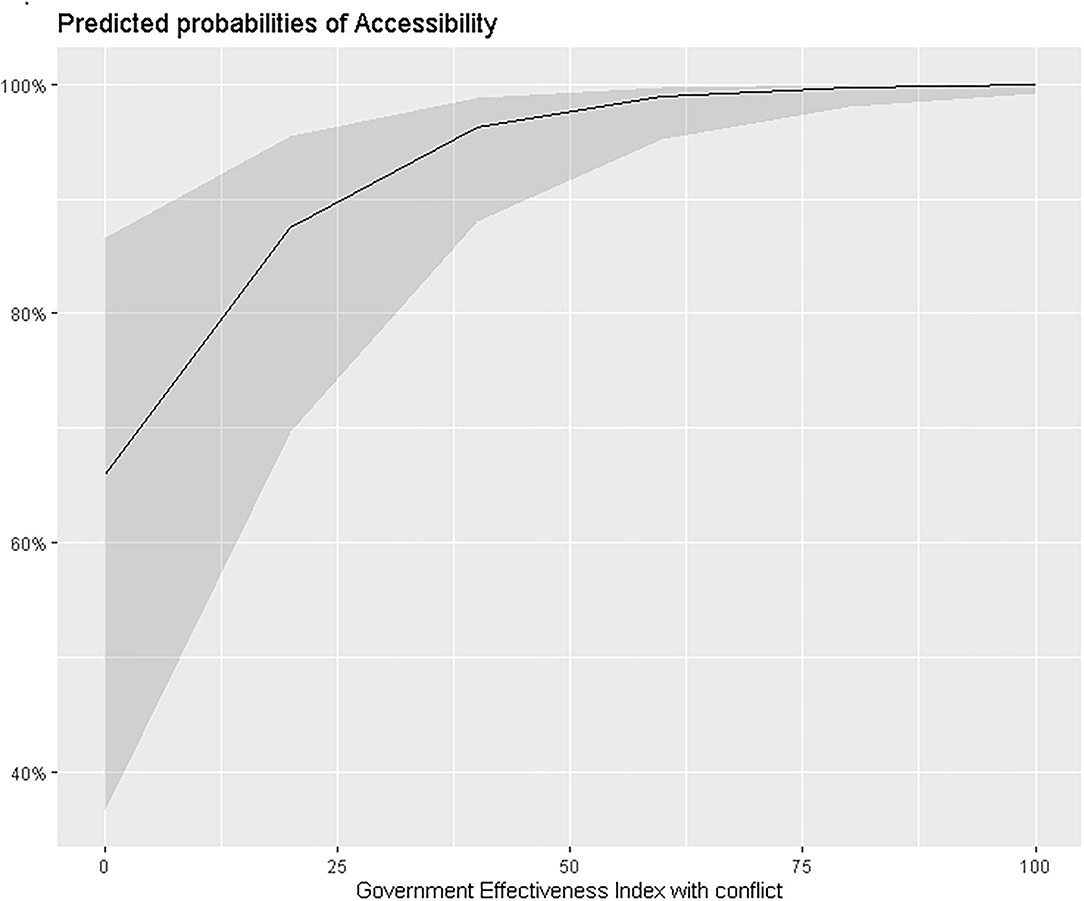
Figure 1. Probability of the ICRC's accessibility predicted by government effectiveness index in cases exposed to armed conflicts (Model 1_5).
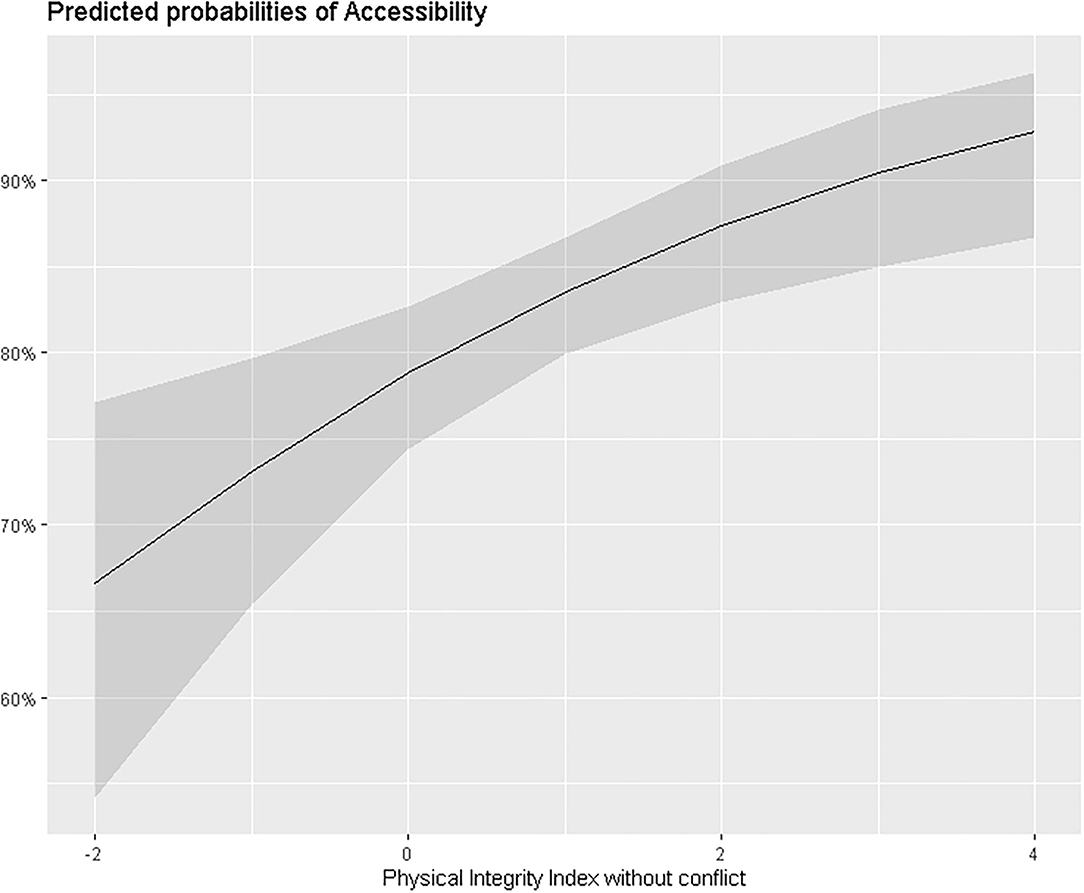
Figure 2. Probability of the ICRC's accessibility predicted by physical integrity index in cases not exposed to armed conflicts (Model 1_6).
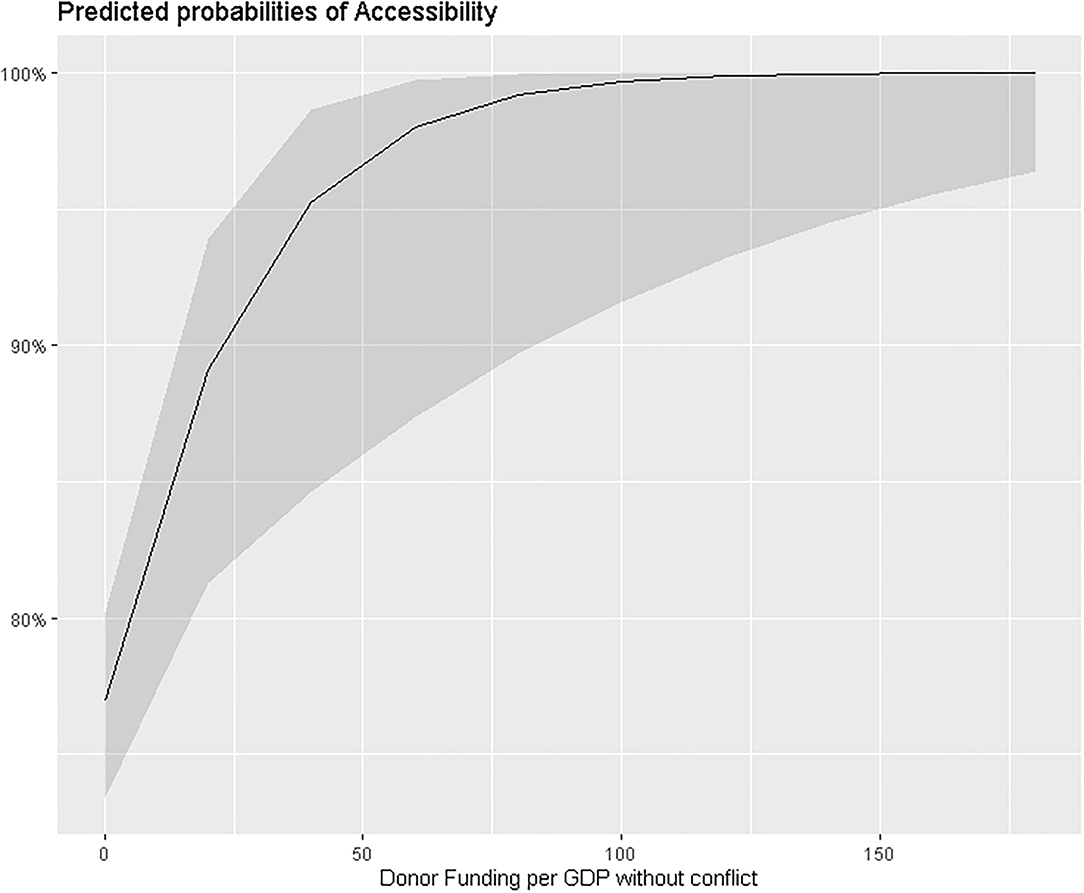
Figure 3. Probability of the ICRC's accessibility predicted by Donor Funding per GDP in cases not exposed to armed conflicts (Model 1_6).
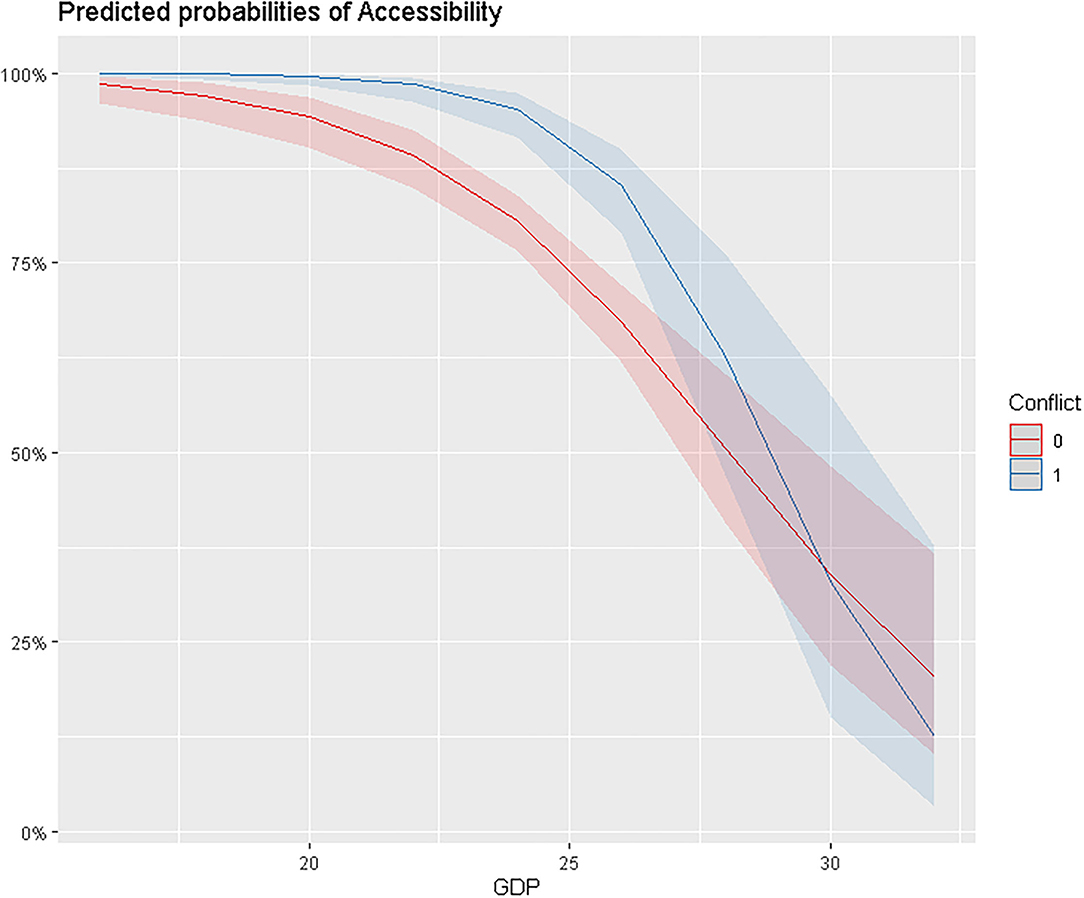
Figure 4. Probability of the ICRC's accessibility predicted by GDP according to exposure to armed conflicts (Model 1_4).
The results of Analysis I find control variables that Analysis II incorporates. They are GEI only in cases exposed to armed conflicts, PII and DON only in cases not exposed to armed conflicts, and GDP in both general cases.
Analysis II
Table 4 shows the results of Analysis II on the ICRC engagement to induce a government to grant access. AIC of Model 2_1 regressed only by control variables is the baseline. Any model with an AIC lesser than 330.2 has variables effective to induce a government to grant access.
ADC is insignificant in any model. This implies that Hypothesis II-MI-1 stands not supported. The ICRC accessibility to detainees does not improve if it provides material assistance for the detention centers.
Artificial intelligence is significant in Models 2_2 and 2_5 with lesser AIC than 330.2. Neither the crossed term of AI with ADC nor HLM is significant. Thus, Hypothesis II-MI-2 stands supported. The ICRC accessibility to detainees improves if the ICRC provides more material assistance for civilians. The leverage does not increase when assistance items for civilians are combined with assistance for detention centers or high-level meetings.
Although HLM is not significant in any model, the p-values in Models 2_4 and 2_5 are <10, 9.9, and 9.7% with AICs <330.2. The ICRC accessibility to detainees may improve if the high-level figures participate in a meeting between the ICRC and the government.
The effects of AI and HLM are shown in the figures. Figure 5 reveals the ICRC accessibility predicted by AI in Model 2_5, showing the lower limit does not change but the upper limit improves dramatically as the number of assistance items delivered increases. Figure 6 presents the prediction by HLM. It shows the possibility of the improvement of the upper limit by holding a high-level meeting.
Discussion
The control is partially supported. This result does not change the findings of previous research but reveals their limitations. Government capacity improves the ICRC accessibility only when the government is not exposed to armed conflicts. It is generally known that a government exposed to armed conflicts is expected to have a fragile administrative capacity (Babajide et al., 2021, p. 1–2; UNDP, 2010, p. 5–6). This tendency is found in this study's dataset. The average value of GEI in cases exposed to armed conflicts is significantly lower than the average value of GEI in cases not exposed to armed conflicts (30.2 vs. 45.8: F < 0.01, p-value at Wilcoxon signed rank test <0.01), which could enhance the ICRC accessibility. In contrast, a government not exposed to armed conflicts has more or less sufficient effective capacity. For such a government, improvement in governance is marginal.
Hypotheses regarding MI, I-MI-1, I-MI-2, and II-MI-2 are supported, and II-MI-1 is not supported. This result is accorded with the findings of previous research and elaborates them. The demand for international assistance caused by its small economy or exposure to armed conflicts improves the ICRC accessibility. However, another interpretation can be considered in the exposure to armed conflicts. Armed conflicts generate a new bunch of detainees as a prisoner of war. Those prisoners of war may be more accessible to the ICRC than political detainees because visiting political detainees is perceived as indirect criticism by the government (Armstrong, 1985, p. 635). Therefore, the positive effect of exposure to armed conflicts is not caused by the demand for foreign assistance but by the increase of more accessible detainees. Indeed, the ICRC sometimes coordinates with a government about the categories of detainees visited (ICRC, 2004, p. 176). This point should be further investigated by more detailed records of the ICRC visits according to the category of detainees. Moreover, the leverage of international assistance is effective, which has not been pointed out by previous research on humanitarian access in a quantitative way. Assistance for detention centers is much less effective than assistance for civilian people. This may be caused by the difference between the amounts of two assistances. However, this implication requires further research. In this study, assistance for detention centers is coded binary, and assistance for civilians is coded of its value. Minute records regarding assistance may find its positive effect more clearly.
Hypothesis I-CI-1 regarding CI is not supported. This result seems to contradict the findings of previous research. Indeed, some governments have utilized granting access to show their international legitimacy (Forsythe, 2005, p. 68–70). Nevertheless, as noted earlier, granting the ICRC access to detainees has no legal basis in most cases, and the ICRC rarely makes a critical statement on the government's refusal of access to detainees. Therefore, a government does not grant the ICRC access to detainees to claim legitimacy in the international forum.
Hypotheses I-CD-1 and I-CD-2 regarding CD are supported, and Hypothesis II-CD-1 is supported less explicitly. This result is accorded with the findings of previous research and elaborates them. The government's concern about exposure to violations of international humanitarian norms hinders the ICRC access. Some governments do not even recognize the existence of such detainees (Moreillon, 1974, p. 173). This is a quite challenging case for the ICRC access to detainees. In this study's dataset, 9 of the 143 governments did not grant the ICRC access to detainees in any single year. Donorship with the ICRC can lessen the government's concern about exposure. Generally speaking, donor governments have power over NGOs that they fund (Reith, 2010, p. 448). Therefore, it is unrealistic to suppose that the ICRC enforces its donor governments to grant it access to detainees. Rather, the donorship reflects the donor government's assumption that the ICRC will not harm its reputation. High-level talk may be useful in some cases to lessen the government's concern. This leverage should be investigated further not only because statistical significance is relatively small, but also because the meeting may simply represent existing trust in the government (Druckman and Wallensteen, 2016, p. 72). The meeting minutes of negotiation for the ICRC access to detainees should be very informative to highlight the effect. Although they are closed in the ICRC archive for 70 years, the ICRC started detainee visit around the 1910s. Therefore, the detailed archival investigation is expected.
A limit of this study is its very rough scope owing to the limitation of accessible data. For instance, the categories of detainees visited and the distinction between “full access” and “partial access” remain unclear in some cases. Although some of those problems can be solved by a more sophisticated computation like inserting instrumental variables (Sovey and Green, 2011), more detailed data are required to develop theory, which is potentially helpful for practitioners and policymakers. This study does not treat material disincentive and ICRC engagement regarding CI. Those two aspects are less crucial for humanitarian access in armed conflicts. Further research incorporating those aspects is required.
Conclusion
To clarify the success factors for humanitarian access, this study conducted a case study on the ICRC detention visits in a quantitative manner. In Analysis I, the attributes of governments were examined. In Analysis II, the study analyzed the ICRC commitments to soften the attitude of the authority that refused the visit.
In summary, this study shows certain new attributes of governments other than those pointed out in previous research. In addition, it quantitatively revealed that it is possible to soften the attitude of the government through the ICRC effective engagement by providing material assistance or setting high-level meeting.
Data Availability Statement
The raw data supporting the conclusions of this article will be made available by the authors, without undue reservation.
Author Contributions
Both authors listed have made a substantial, direct, and intellectual contribution to the work and approved it for publication.
Funding
This work was supported by JSPS KAKENHI (Grant No. JP20K01501).
Conflict of Interest
The authors declare that the research was conducted in the absence of any commercial or financial relationships that could be construed as a potential conflict of interest.
Publisher's Note
All claims expressed in this article are solely those of the authors and do not necessarily represent those of their affiliated organizations, or those of the publisher, the editors and the reviewers. Any product that may be evaluated in this article, or claim that may be made by its manufacturer, is not guaranteed or endorsed by the publisher.
Supplementary Material
The Supplementary Material for this article can be found online at: https://www.frontiersin.org/articles/10.3389/fpos.2022.928713/full#supplementary-material
Footnotes
1. ^Research on humanitarian access usually uses “authority” to denote the party with which humanitarian agencies negotiate. It includes governments and rebel groups. This study used “authority” to refer to general humanitarian access. It used “government” in explaining humanitarian access in the research design, which treats only governments.
2. ^In the paper, mere “detainees” means detainees whom ICRC targets to visit, prisoners of war, political detainees, and illegal migrants. They are different from detainees who have violated penal law, mentioned as “common detainees” (Aeschlimann, 2005, p. 88).
3. ^Universal Periodic Review started in 2008. Physical integrity index has been recorded till 2017.
4. ^The values of 1997, 1999, and 2001 are omitted from the original data. Provided that governance effectiveness is assumed to change in a linear way, the values of 1997, 1999, and 2001 are the average value by those values of the previous and successive years.
5. ^Physical integrity rights are rights related to the following issues: justice, death penalty, detention, enforced disappearances, extrajudicial executions, and human rights violations by state agents, impunity, and torture (Terman and Byun, 2022).
6. ^When the ICRC report accounts for aggregated amount by some countries for assistance items, AI is calculated by the ratio of the numbers of those country's populations.
References
Aeschlimann, A.. (2005). Protection of detainees: ICRC action behind bars. Int. Rev. Red Cross 87, 83–122. doi: 10.1017/S1816383100181202
Allié, P.. (2011). “Introduction: acting at any price?,” in Humanitarian Negotiation Revealed: The MSF Experience, eds C. Magone, M. Neuman, and F. Weissman (London: C. Hurst & Co. Ltd).
Anderson, M. B.. (1999). Do No Harm: How Aid Can Support Peace – or War. Colorado: Lynne Rienner Publishers, Inc. doi: 10.1515/9781685854065
Armstrong, J. D.. (1985). The international committee of the red cross and political prisoners. Int. Organ. 39, 615–642. doi: 10.1017/S0020818300027041
Babajide, A., Ahmad, A. H., and Coleman, S. (2021). Violent conflicts and state capacity: evidence from Sub-Saharan Africa. J. Govern. Econ. 3, 1–14. doi: 10.1016/j.jge.2021.100019
Bangerter, O.. (2011). Reasons why armed groups choose to respect international humanitarian law or not. Int. Rev. Red Cross 93, 353–384. doi: 10.1017/S1816383111000385
Bussmann, M., and Schneider, G. (2016). A porous humanitarian shield: the laws of war, the red cross, and the killing of civilians. Rev. Int. Organ. 11, 337–359. doi: 10.1007/s11558-015-9233-9
Clements, A. J.. (2018). Overcoming power asymmetry in humanitarian negotiations with armed groups. Int. Negot. 23, 367–393. doi: 10.1163/15718069-23031136
Cunningham, A. J.. (2018). International Humanitarian NGOs and State Relations : Politics, Principles and Identity. Oxon: Routledge. doi: 10.4324/9781315169750
Cutts, M.. (1999). Negotiating warring parties. Refugee Surv. Q. 18, 43–46. doi: 10.1093/rsq/18.3.43
Del Valle, H., and Healy, S. (2013). Humanitarian agencies and authoritarian states: a symbiotic relationship? Disasters 37, 188–201. doi: 10.1111/disa.12021
Druckman, D., and Wallensteen, P. (2016). Summit meetings: good or bad for peace. Glob. Summitry 2, 71–92. doi: 10.1093/global/gux001
Fariss, C. J.. (2014). Respect for human rights has improved over time: modeling the changing standard of accountability. Am. Polit. Sci. Rev. 108, 297–318. doi: 10.1017/S0003055414000070
Fariss, C. J.. (2019). Yes, human rights practices are improving over time. Am. Polit. Sci. Rev. 113, 868–881. doi: 10.1017/S000305541900025X
Forsythe, D. P.. (2005). The Humanitarians: The International Committee of the Red Cross. New York, NY: Cambridge University Press.
Glaser, M. P.. (2005). Humanitarian Engagement With Non-State Armed Actors: The Parameters of Negotiated Access. Network Paper no. 51, June. London: Humanitarian Practice Network.
Grace, R.. (2020). The humanitarian as negotiator: developing capacity across the aid sector. Negot. J. 36, 13–41. doi: 10.1111/nejo.12307
Haver, K., and Carter, W. (2016). What it Takes: Principle Pragmatism to Enable Access and Quality Humanitarian Aid in Insecure Environments. Report from the, Secure Access in Volatile Environments Research Programme. Humanitarian Outcome.
Herrero, S.. (2014). Negotiating Humanitarian Access: Between a Rock and a Hard Place. Professionals in Humanitarian Assistance and Protection. Available online at: https://www.humanitarianresponse.info/fr/topics/transformative-agenda/document/negotiating-humanitarian-access-between-rock-and-hard-place (accessed June 17, 2022).
Hugh, G. M., and Bessler, M. (2006). Humanitarian Negotiations With Armed Groups: A Manual for Practitioners. New York, NY: OCHA.
Jo, H., and Bryant, K. (2013). “Taming of the warlords: commitment and compliance by armed opposition groups in civil wars,” in The Persistent Power of Human Rights: From Commitment to Compliance, eds T. Risse, S. C. Ropp, and K. Sikkink (Cambridge: Cambridge University Press), 239–258. doi: 10.1017/CBO9781139237161.018
Jo, H., and Thomson, C. P. (2014). Legitimacy and compliance with international law: access to detainees in civil conflicts, 1991–2006. Br. J. Polit. Sci. 44, 323–355. doi: 10.1017/S0007123412000749
Kaufmann, D., Kraay, A., and Mastruzzi, M. (2010). The Worldwide Governance indicators: Methodology and Analytical Issues. Policy Research Working Paper, no. 5430. The World Bank.
Kellenberger, J.. (2004). Speaking out or remaining silent in humanitarian work. Int. Rev. Red Cross 86, 593–609. doi: 10.1017/S1560775500181052
Kotsioni, I.. (2016). Detention of migrants and asylum-seekers: the challenge for humanitarian actors. Refugee Surv. Q. 35, 41–55. doi: 10.1093/rsq/hdw004
Kunz, N., and Reiner, G. (2016). Drivers of government restriction on humanitarian supply chains: an exploratory study. J. Hum. Logist. Supply Chain Manage. 6, 329–351. doi: 10.1108/JHLSCM-04-2016-0009
Kunz, N., Van Wassenhove, L. N., Besiou, M., Hambye, C., and Kovács, G. (2017). Relevance of humanitarian logistics research: best practices and way forward. Int. J. Operat. Product. Manage. 37, 1585–1599. doi: 10.1108/IJOPM-04-2016-0202
Labonte, M. T., and Edgerton, A. C. (2013). Towards a typology of humanitarian access denial. Third World Q. 34, 39–57. doi: 10.1080/01436597.2012.755015
Lewis, N. A.. (2004). Red Cross Finds Detainee Abuse in Guantánamo. New York Times, 30 November 2004. Available online at: https://www.nytimes.com/2004/11/30/politics/red-cross-finds-detainee-abuse-in-guantanamo.html (accessed June 17, 2022).
Mampilly, Z. C.. (2011). Rebel Rulers: Insurgent Governance and Civilian Life During War. New York, NY: Cornell University Press.
Mancini-Griffoli, D., and Picot, A. (2004). Humanitarian Negotiation: A Handbook for Securing Access, Assistance and Protection for Civilians in Armed Conflict. Geneva: Centre for Humanitarian Dialogue.
Minear, L.. (2007). “The craft of humanitarian diplomacy,” in Humanitarian Diplomacy: Practitioners and their Craft, eds L. Minear, and H. Smith (Tokyo: United Nations University Press), 7–35.
Moreillon, J.. (1974). The international committee of the red cross and the protection of political detainees. Int. Rev. Red Cross 14, 585–595. doi: 10.1017/S0020860400018520
Moslehi, S., Fatemi, F., Mahboubi, M., Mozafarsaadati, H., and Karami, S. (2015). The Challenges and recommendations of accessing to affected population for humanitarian access: a narrative review. Glob. J. Health Sci. 7, 111–115. doi: 10.5539/gjhs.v7n3p111
Paik, W.. (2011). Authoritarianism and humanitarian aid: regime stability and external relief in China and Myanmar. Pac. Rev. 24, 439–462. doi: 10.1080/09512748.2011.596560
Reith, S.. (2010). Money, power, and donor–NGO partnerships. Dev. Pract. 20, 446–455. doi: 10.1080/09614521003709932
Richardson, A.. (2002). Negotiating humanitarian access in Angola: 1990-2000. Refugee Surv. Q. 21, 74–112. doi: 10.1093/rsq/21.1_and_2.74
Rohwerder, B.. (2015). Restrictions on Humanitarian Access. GSDRC Helpdesk Research Report 1297. Birmingham: University of Birmingham.
Sovey, A. J., and Green, D. P. (2011). Instrumental variables estimation in political science: a researcher's guide. Am. J. Polit. Sci. 55, 188–200. doi: 10.1111/j.1540-5907.2010.00477.x
Stina, H.. (2021). UCDP GED Codebook Version 21.1. Department of Peace and Conflict Research, Uppsala University.
Sundberg, R., and Melander, E. (2013). Introducing the UCDP georeferenced event dataset. J. Peace Res. 50, 523–532. doi: 10.1177/0022343313484347
Terman, R., and Byun, J. (2022). Punishment and politicization in the international human rights regime. Am. Polit. Sci. Rev. 116, 385–402. doi: 10.1017/S0003055421001167
Terry, F.. (2002). Condemned to Repeat? The Paradox of Humanitarian Action. Ithaca, NY: Cornell University Press.
Tuck, D.. (2011). Detention by armed groups: overcoming challenges to humanitarian action. Int. Rev. Red Cross 93, 759–782. doi: 10.1017/S1816383112000069
UNOCHA (2017). OCHA on Message: Humanitarian Access. Available online at: https://www.unocha.org/sites/unocha/files/dms/Documents/OOM-humanitarianAccess_eng_April2017.pdf (accessed June 17, 2022).
Keywords: humanitarian access, humanitarian organization, international committee of the red cross, detainee, humanitarian diplomacy
Citation: Futsuki K and Sekiyama T (2022) Success Factors for Humanitarian Access: Quantitative Case Studies of ICRC Visits to Detainees. Front. Polit. Sci. 4:928713. doi: 10.3389/fpos.2022.928713
Received: 16 May 2022; Accepted: 22 June 2022;
Published: 04 August 2022.
Edited by:
Krzysztof Goniewicz, Polish Air Force University, PolandReviewed by:
Simon Horne, Plymouth Hospitals NHS Trust, United KingdomDorota Lasota, Medical University of Warsaw, Poland
Copyright © 2022 Futsuki and Sekiyama. This is an open-access article distributed under the terms of the Creative Commons Attribution License (CC BY). The use, distribution or reproduction in other forums is permitted, provided the original author(s) and the copyright owner(s) are credited and that the original publication in this journal is cited, in accordance with accepted academic practice. No use, distribution or reproduction is permitted which does not comply with these terms.
*Correspondence: Kouta Futsuki, ZnV0c3VraS5rb3V0YS4yMnVAc3Qua3lvdG8tdS5hYy5qcA==
 Kouta Futsuki
Kouta Futsuki Takashi Sekiyama
Takashi Sekiyama